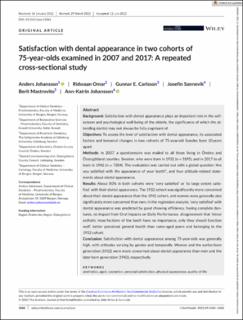Satisfaction with dental appearance in two cohorts of 75-year-olds examined in 2007 and 2017: A repeated cross-sectional study
Johansson, Anders Arne; Omar, Ridwaan; Carlsson, Gunnar E.; Sannevik, Josefin; Mastrovito, Berit; Johansson, Gerd Ann-Katrin Janmyr
Journal article, Peer reviewed
Published version

Åpne
Permanent lenke
https://hdl.handle.net/11250/3042615Utgivelsesdato
2022Metadata
Vis full innførselSamlinger
Sammendrag
Background
Satisfaction with dental appearance plays an important role in the self-esteem and psychological well-being of the elderly, the significance of which the attending dentist may not always be fully cognisant of.
Objectives
To assess the level of satisfaction with dental appearance, its associated factors and temporal changes in two cohorts of 75-year-old Swedes born 10 years apart.
Methods
In 2007, a questionnaire was mailed to all those living in Örebro and Östergötland counties, Sweden, who were born in 1932 (n = 5195), and in 2017 to all born in 1942 (n = 7204). The evaluation was carried out with a global question ‘Are you satisfied with the appearance of your teeth?’, and four attitude-related statements about dental appearance.
Results
About 80% in both cohorts were ‘very satisfied’ or ‘to large extent satisfied’ with their dental appearance. The 1932 cohort was significantly more concerned about their dental appearance than the 1942 cohort, and women were generally also significantly more concerned than men. In the regression analysis, ‘very satisfied’ with dental appearance was predicted by good chewing efficiency, having complete dentures, no impact from Oral Impacts on Daily Performance, disagreement that ‘minor esthetic imperfections of the teeth have no importance, only they should function well’, better perceived general health than same-aged peers and belonging to the 1932 cohort.
Conclusion
Satisfaction with dental appearance among 75-year-olds was generally high, with attitudes varying by gender and temporally. Women and the earlier-born generation (1932) were more concerned about dental appearance than men and the later-born generation (1942), respectively.
